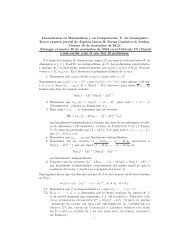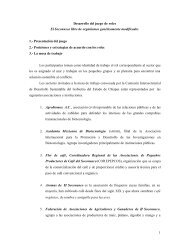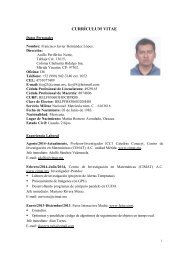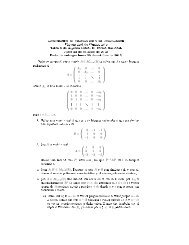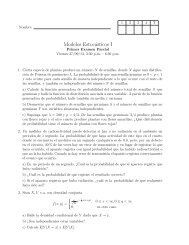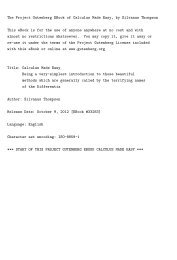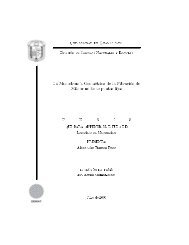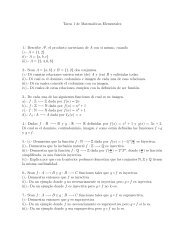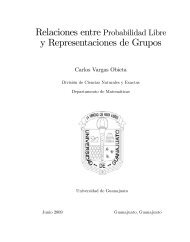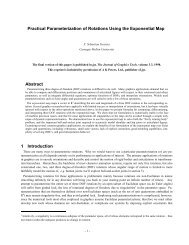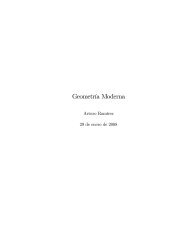Denote the corresp<strong>on</strong>ding element of Pic 2 (C) by D. We will choose ∞ + + ∞ − asa representative for D. Since D is the can<strong>on</strong>ical class, the Riemann Roch Theoremimplies that any other element of Pic 2 (C) c<strong>on</strong>tains precisely <strong>on</strong>e effective divisor P + Qfixed as a pair by Gal( ¯Q/Q) (see [16, Chapter 1, Secti<strong>on</strong> 1]). We will identify any suchelement of Pic 2 (C) with its unique effective divisor. We can identify Pic 0 (C) with Pic 2 (C)via additi<strong>on</strong> by D. Doing so identifies 0 ∈ Pic 0 (C) with D. We will in general express<str<strong>on</strong>g>points</str<strong>on</strong>g> <strong>on</strong> the Jacobian other than 0 in the form P + Q − D, where P and Q are notc<strong>on</strong>jugate under the <strong>hyperelliptic</strong> involuti<strong>on</strong>.Let P 0 be a rati<strong>on</strong>al point <strong>on</strong> C. Sometimes we will want to express <str<strong>on</strong>g>points</str<strong>on</strong>g> in theJacobian in the form P ′ + Q ′ − 2P 0 . We will do it in the following way. Let P + Q − Dbe an element in J(C). C<strong>on</strong>sider the divisor D ′ = P + Q − D + P 0 − ¯P 0 ∈ Pic 0 (C). Ingeneral, D ′ will not be linearly equivalent to 0. Let P ′ +Q ′ be the <strong>on</strong>ly degree 2 effectivedivisor such that P ′ +Q ′ −D is linearly equivalent to D ′ . Then the divisor P ′ +Q ′ −2P 0is linearly equivalent to D ′ + D − 2P 0 , which is linearly equivalent to P + Q − P 0 − ¯P 0 ,which is linearly equivalent to P + Q − D.The Jacobian of the curve J(C) can also be thought of as an algebraic varietywhose <str<strong>on</strong>g>points</str<strong>on</strong>g> corresp<strong>on</strong>d to the elements of Pic 0 (C). In [16, Chapter 2] the authorsdescribe explicitly this variety as the intersecti<strong>on</strong> of 72 quadrics in P 15 and they alsogive explicit maps taking divisors of the form P + Q − D to the algebraic variety.The model of the Jacobian variety in P 15 is a large object, difficult to manipulate.There is another variety associated to J(C) that retains much of the informati<strong>on</strong> of theJacobian which is much simpler, the Kummer surface K = K(C). This is a quarticsurface in P 3 . We take its definiti<strong>on</strong> from [16, Chapter 3]. We define K as the projectivelocus in P 3 of the map given byP + Q − D ∈ J(C) ↦→ (k 1 , k 2 , k 3 , k 4 ) = (1, x + u, xu, (F 0 (x, u) − 2yv)/(x − u) 2 ),where P = (x, y), Q = (u, v), P ≠ Q, andF 0 (x, u) = 2f 0 +f 1 (x+u)+2f 2 xu+f 3 xu(x+u)+2f 4 (xu) 2 +f 5 (xu) 2 (x+u)+2f 6 (xu) 3 .9
The Kummer surface is then given by a quartic equati<strong>on</strong>R(k 1 , k 2 , k 3 )k 2 4 + S(k 1 , k 2 , k 3 )k 4 + T (k 1 , k 2 , k 3 ) = 0, (2.1.1)where R, S and T are homogeneous of degree 2, 3 and 4 respectively. These polynomialscan be found in Chapter 3 of [16]. We can extend the map to pairs of <str<strong>on</strong>g>points</str<strong>on</strong>g>P, Q that include the <str<strong>on</strong>g>points</str<strong>on</strong>g> at infinity, and to pairs of the form P, P . The values arethe following, according to Flynn and Smart [22]. For pairs P, P where P is not <strong>on</strong>e ofthe <str<strong>on</strong>g>points</str<strong>on</strong>g> at infinity, k 1 , k 2 , k 3 are as above, and k 4 is uniquely determined by Equati<strong>on</strong>(2.1.1). If the pair is of the form (x, y), ∞ ± , then k 1 = 0, k 2 = 1, k 3 = x 1 , k 4 =f 5 x 2 + 2f 6 x 3 1 − (±2y√ f 6 ). The pair ∞ + , ∞ − is mapped to (0, 0, 0, 1) and if the pairc<strong>on</strong>sists of two equal <str<strong>on</strong>g>points</str<strong>on</strong>g> at infinity, the corresp<strong>on</strong>ding point <strong>on</strong> the Kummer surfaceis (0, 0, 1, k 4 ) where k 4 can be determined from equati<strong>on</strong> (2.1.1). We remark that theJacobian variety is a double cover of the Kummer surface (see [16, Chapter 3, Secti<strong>on</strong>8]).Finally, we state the Mordell–Weil Theorem. The proof for the general theorem<strong>on</strong> Abelian varieties over number fields can be found in Serre’s book [39, Chapter 4].Theorem 2.1.1. The group of <str<strong>on</strong>g>points</str<strong>on</strong>g> <strong>on</strong> J(C) defined over Q is a finitely generatedabelian group.2.2 Bounds for the height differenceWe define a naive height <strong>on</strong> K as the restricti<strong>on</strong> of the naive height in P 3 : let (x 0 , x 1 , x 2 , x 3 )be the homogeneous coordinates of a point in P 3 (Q). Multiplying by a n<strong>on</strong>zero c<strong>on</strong>stant,we can assume that the x i s are all integers having 1 as their greatest comm<strong>on</strong> divisor.We define the (exp<strong>on</strong>ential) naive height of (x 0 , x 1 , x 2 , x 3 ) as max(|x 0 |, |x 1 |, |x 2 |, |x 3 |).We will normally c<strong>on</strong>sider the logarithmic naive height, that is, the logarithm of the naiveheight.Definiti<strong>on</strong>. The naive height or logarithmic height of a point Q <strong>on</strong> the Jacobian variety10
- Page 1 and 2: S-integral <strong
- Page 3: 3.3 Systems of fundamental units .
- Page 6 and 7: AcknowledgmentsTo the glory of my G
- Page 8 and 9: DeclarationsI declare that, except
- Page 10 and 11: Chapter 1IntroductionConsider the h
- Page 12 and 13: As mentioned earlier, Step (I’) h
- Page 14 and 15: present an algorithm of Bost and Me
- Page 16 and 17: Chapter 2The Mordell-Weil groupThe
- Page 20 and 21: of C is the logarithmic naive heigh
- Page 22 and 23: For the computation of the canonica
- Page 24 and 25: Once we find r linearly independent
- Page 26 and 27: then it should have strictly lower
- Page 28 and 29: integral p
- Page 30 and 31: and such that all y(P i ) are non-z
- Page 32 and 33: mapped to x − α (mod Q ∗ K ∗
- Page 34 and 35: the ring of integers of K is the us
- Page 36 and 37: Proof. Recall that ‖ε‖ υ = 1
- Page 38 and 39: Proof. Note that for any place υ i
- Page 40 and 41: We will also need a bound for the c
- Page 42 and 43: a large field, we get one in terms
- Page 44 and 45: We will compute a lower bound for t
- Page 46 and 47: Choose nowδ = 2c 9 (n, d)H h(µ 1
- Page 48 and 49: c ∗ 14 = 2H∗ d s 1+s 2 −2 P d
- Page 50 and 51: To ease notation we write A 1 + A 2
- Page 52 and 53: Let f(x) = x 5 − 16x + 8. Let α
- Page 54 and 55: 3.8 The Mordell-Weil sieveWe have g
- Page 56 and 57: of the first 22 primes. We transfor
- Page 58 and 59: The reader can find the MAGMA progr
- Page 60 and 61: The AGM of two positive real number
- Page 62 and 63: Note that sgn(t) does not change al
- Page 64 and 65: 4.2 Bost and Mestre’s algorithmIn
- Page 66 and 67: Lemma 4.2.4 (I-3). Let P, Q ∈ R[X
- Page 68 and 69:
and[U, V ] = −2R∆(P, Q, R),[V,
- Page 70 and 71:
andU(x) = [Q, R](x) = (b + b ′
- Page 72 and 73:
then F 1 is precisely of degree 2 a
- Page 74 and 75:
Lemma 4.2.10 (III-3-a). We have z 1
- Page 76 and 77:
and∫ x0wS(z 1 (x))z ′ 1 (x)dxy
- Page 78 and 79:
intervals whose endpoints</
- Page 80 and 81:
C to the integrals
- Page 82 and 83:
for [U n , V n ] and [W n , U n ],
- Page 84 and 85:
Since I n converges, T n converges
- Page 86 and 87:
and a sum of integral</stro
- Page 88 and 89:
2 = a 1a ′ 1 − b 1b ′ 1 + √
- Page 90 and 91:
• Else do- PutandIH i = θ √⎧
- Page 92 and 93:
and⎧⎪⎨ −1, (a n,i = b and x
- Page 94 and 95:
algorithm used for the multiplicati
- Page 96 and 97:
interested in. The roots of f are m
- Page 98 and 99:
assuming that the polynomial f defi
- Page 100 and 101:
the g × 2g matrix⎛∫∫∫ ⎞A
- Page 102 and 103:
curves with the point at infinity a
- Page 104 and 105:
We are now interested in the numeri
- Page 106 and 107:
conformed ourselves with estimates
- Page 108 and 109:
Let P be an integral</stron
- Page 110 and 111:
We will now find an upper bound for
- Page 112 and 113:
for the divisors D 1 = (−1, 1)
- Page 114 and 115:
Proof. Since c 16 > 0, then X(P ) i
- Page 116 and 117:
now want to estimate the height of
- Page 118 and 119:
and for all x ≤ −c 16max{ ∫ x
- Page 120 and 121:
andφ(2D i )2= (d i,1 , d i,2 ) ∈
- Page 122 and 123:
Again, by our assumption, the right
- Page 124 and 125:
The reader can find the MAGMA progr
- Page 126 and 127:
[8] Nils Bruin, Chabauty methods us
- Page 128 and 129:
[30] Serge Lang, Algebraic number t
- Page 130:
[51] Michel Waldschmidt, Diophantin



